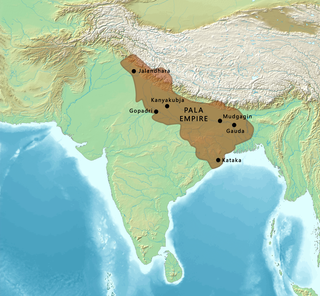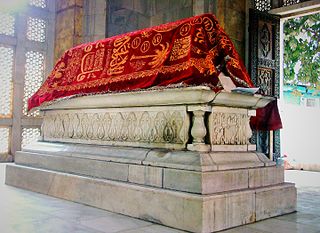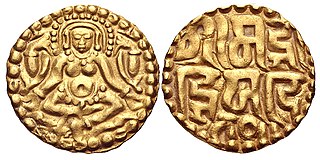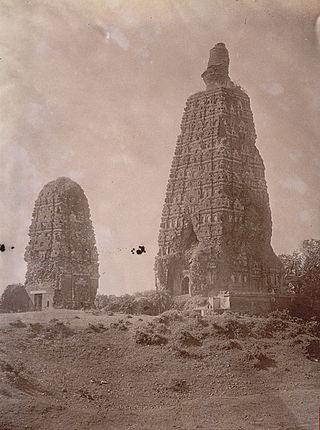
Mu'izz ad-Din Muhammad ibn Sam, also known as Muhammad of Ghor or Muhammad Ghori, was a ruler from the Ghurid dynasty based in the Ghor region of what is today central Afghanistan who ruled from 1173 to 1206. Muhammad and his elder brother Ghiyath al-Din Muhammad ruled in a dyarchy until the latter's death in 1203. Ghiyath al-Din, the senior partner, governed the western Ghurid regions from his capital at Firozkoh whereas Muhammad extended Ghurid rule eastwards, laying the foundation of Islamic rule in South Asia, which lasted after him for nearly half a millennium under evolving Muslim dynasties.

The Pāla Empire was an imperial power during the post-classical period in the Indian subcontinent, which originated in the region of Bengal. It is named after its ruling dynasty, whose rulers bore names ending with the suffix Pāla. The empire was founded with the election of Gopāla as the emperor of Gauda in late eighth century CE. The Pala stronghold was located in Bengal and eastern Bihar, which included the major cities of Gauḍa, Vikramapura, Pāṭaliputra, Monghyr, Somapura, Ramavati (Varendra), Tāmralipta and Jagaddala.

Qutb ud-Din Aibak, was a general of the Ghurid emperor Muhammad Ghori. He was in charge of the Ghurid territories in northern India, and after Muhammad Ghori's assassination in 1206, he established the Delhi Sultanate (1206–1526), and started the Mamluk dynasty, which would rule the Sultanate until 1290.

The Sena dynasty was a Hindu dynasty during the early medieval period on the Indian subcontinent, that ruled from Bengal through the 11th and 12th centuries. The empire at its peak covered much of the north-eastern region of the Indian subcontinent. The rulers of the Sena Dynasty traced their origin to the south Indian region of Karnataka.

Prithviraja III, popularly known as Prithviraj Chauhan or Rai Pithora, was a king from the Chauhan (Chahamana) dynasty who ruled the territory of Sapadalaksha, with his capital at Ajmer in present-day Rajasthan. Ascending the throne as a minor in 1177 CE, Prithviraj inherited a kingdom which stretched from Thanesar in the north to Jahazpur (Mewar) in the south, which he aimed to expand by military actions against neighbouring kingdoms, most notably defeating the Chandelas.

The Chandelas of Jejakabhukti was an Indian dynasty in Central India. The Chandelas ruled much of the Bundelkhand region between the 9th and the 13th centuries. They belonged to the Chandel clan of the Rajputs.

The Gahadavala dynasty also Gahadavalas of Kannauj was a Rajput dynasty that ruled parts of the present-day Indian states of Uttar Pradesh and Bihar, during 11th and 12th centuries. Their capital was located at Banaras in the Gangetic plains, and for a brief period, they also controlled Kannauj.
The Ghurid dynasty was a Persianate dynasty of presumably eastern Iranian Tajik origin, which ruled from the 8th-century in the region of Ghor, and became an Empire from 1175 to 1215. The Ghurids were centered in the hills of the Ghor region in the present-day central Afghanistan, where they initially started out as local chiefs. They gradually converted to Sunni Islam after the conquest of Ghor by the Ghaznavid ruler Mahmud of Ghazni in 1011. The Ghurids eventually overran the Ghaznavids when Muhammad of Ghor seized Lahore and expelled the Ghaznavids from their last stronghold.
Jaya-chandra was a king from the Gahadavala dynasty of northern India. He is also known as Jayachchandra in inscriptions, and Jaichand in vernacular legends. He ruled the Antarvedi country in the Gangetic plains, including the important cities of Kannauj and Varanasi. His territory included much of the present-day eastern Uttar Pradesh and some parts of western Bihar. The last powerful king of his dynasty, he was defeated and killed in 1194 CE, in a battle near Yamuna against a Ghurid army led by Muhammad of Ghor.
Lakshmana Sena or Lakshman Sen was the ruler from the Sena dynasty of the Bengal region on the Indian subcontinent. His rule lasted for 28 years.

The Kalachuris of Tripuri, also known the Kalachuris of Chedi, ruled parts of central India during 7th to 13th centuries. They are also known as the Later Kalachuris to distinguish them from their earlier namesakes, especially the Kalachuris of Mahishmati. Their core territory included the historical Chedi region, and their capital was located at Tripuri.
Chandradeva, also known as Chandraditya, was an Indian king from the Gahadavala dynasty. He ruled the Antarvedi country in present-day Uttar Pradesh, including Kanyakubja and Varanasi.
Madana-pala, also known as Madana-chandra, was an Indian king from the Gahadavala dynasty. He ruled the Antarvedi country in present-day Uttar Pradesh, including Kanyakubja and Varanasi.

Govindachandra was an Indian king from the Gahadavala dynasty. He ruled the Antarvedi country in present-day Uttar Pradesh, including the major cities of Kanyakubja and Varanasi.
Vijaya-chandra was an Indian king from the Gahadavala dynasty. He ruled the Antarvedi country in the Gangetic plains, which includes a major part of the present-day eastern Uttar Pradesh, including Varanasi. He probably also ruled some parts of western Bihar through his feudatories. He is believed to have repulsed a Ghaznavid invasion.
Harishchandra was an Indian king from the Gahadavala dynasty. The last known king from the family's imperial branch, he probably ruled a part of his ancestral kingdom in present-day Uttar Pradesh.
The Vishnu Hari inscription is the name given to a Sanskrit language inscription found in the Uttar Pradesh state of India. It records the construction of a temple by Anayachandra, a feudatory of the king named Govindachandra, and also contains a eulogy of Anayachandra's dynasty. Its date portion is missing, and its authenticity has been a matter of controversy.

Ramachandra, also known as Ramadeva, was a ruler of the Seuna (Yadava) dynasty of Deccan region in India. He seized the throne from his cousin Ammana, after staging a coup in the capital Devagiri. He expanded the Yadava realm by fighting his neighbours such as the Paramaras, the Vaghelas, the Hoysalas, and the Kakatiyas.

The Pīṭhīpatis of Bodh Gaya were the rulers of the area around Bodh Gaya from roughly the 11th to 13th centuries in the Magadha region of what is now Bihar in India. Pithi refers to the diamond throne where the Buddha was said to have gained enlightenment.

The Ghurid campaigns in India were a series of invasions for 31 years (1175–1206) by the Ghurid ruler Muhammad of Ghor in the last quarter of the twelfth and early decade of the thirteenth century which lead to the widespread expansion of the Ghurid empire in the Indian subcontinent.











